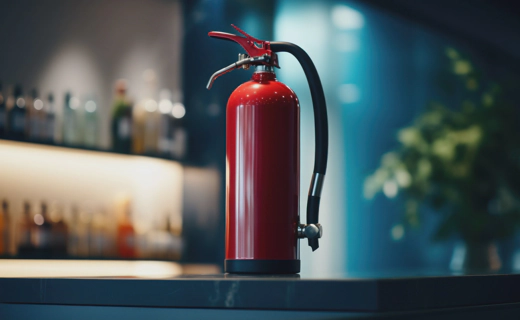Do you have an overview of flammable substances on your properties?
2020-08-06 Academic Fire engineering PiD Drift Risk assessment
Many building owners are unsure of which requirements apply.
With several different parties with the right to use the same commercial property, it can be challenging to keep track of the total amount of hazardous substances stored on the property.

Text: Lars Haugrud,
Senior Consultant at PiD Solutions AS
There are a number of provisions regarding the storage of hazardous substances described in both legislation, regulations and guides, with the Fire and Explosion Protection Act at the top, and the special regulation Regulations on the handling of flammable, reactive and pressurized substances as well as equipment and facilities used in their handling (regulations on the handling of hazardous substances), below it.
In addition, the following thematic guides apply:
- Thematic guide on the production and processing of hazardous substances
- Thematic guide on the storage of hazardous substances
- Thematic guide on the bottling of hazardous substances
- Thematic guide on the transport and distribution of petroleum in pipelines over land
- Thematic guide on the use of hazardous substances – Part 1
- Thematic guide on the use of hazardous substances – Part 2
- Thematic guide on obtaining consent
But what does this mean for you?
It depends on what role you have. Both the regulations on fire prevention and the regulations on the handling of flammable substances distinguish between different areas of responsibility based on the different roles you have. This can be farm owner, user, tenant, business, etc.
Overall, the owner of a building must implement routines that ensure that the fire safety requirements that apply to the building are complied with. This also applies to the handling of hazardous substances.
The owner must also ensure that various users who have the right to use the building (tenants) receive sufficient information so that they can ensure that the building is used in accordance with the fire safety requirements that apply to the building, ref. Fire Prevention Regulations §9 and §11.
Furthermore, businesses that are tenants in or of a building must also ensure that they implement routines that ensure that people with a workplace in the building have sufficient knowledge and skills in preventing and fighting a fire. If there are several tenants in the building, the owner must ensure that all use is coordinated in a way that contributes to preventing fire.
We note that the fire service is increasingly concerned with flammable liquids and gases during their inspections of fire objects, and whether the requirements for, among other things, safe storage are being followed. Some of these requirements are regulated in regulations on the handling of hazardous substances, which we will look at in more detail here.
Storage of flammable liquids and gases – Experience
Flammable liquids and gases are stored and handled differently depending on who owns the property, what use is intended, and internal routines in the individual premises. It is also often seen that a common understanding has not been established for how this should be done.
We have particularly looked at measures in sales premises in commercial buildings:
- Shopping centres
- Department stores
- Supermarkets
- DIY stores
- Smaller commercial buildings with mixed use (e.g. sales premises on the first floor and offices or residential units in the remaining part of the building)
In our own developed system, PiD Drift, a simple survey of tenants’ storage of flammable liquids and gases has been carried out using digital forms. Based on this survey, we estimate that approx. 10% of sales premises in Norway handle flammable liquids and gases during normal operation.
A fire involving flammable liquids and gases can spread very quickly and make extinguishing efforts demanding. This can lead to an increased risk of personal injury, but also an increased risk of major material damage. For premises that handle hazardous substances, a rapid spread of fire can therefore be expected, which will also lead to nearby businesses being affected. In addition, the risk of a fire occurring will be greater where such goods are stored and handled.

The regulations
There are requirements for both care, maximum stored quantities, material requirements for the areas in which they are stored, as well as requirements for competence when storing and handling flammable liquids and gases. Regulations on the handling of hazardous substances § 7 regulate, among other things, the requirements for competence for everyone involved in the handling of both flammable liquids and gases:
“Anyone who designs, constructs, installs, operates, modifies, repairs, maintains or checks equipment and facilities used in the handling of hazardous substances shall have the necessary competence.”
The same applies to anyone who handles hazardous substances beyond what is intended for the person’s personal use.
The competence shall include knowledge of current regulations, the hazardous substances to be handled and the technical design and operation of equipment and facilities. Where there are recognized standards for competence, the content of these shall be used as a minimum level.
The competence shall be maintained so that one is updated on new regulations, new methods and




